
 Fengxiang-cradle of clay-figurine
Fengxiang-cradle of clay-figurine
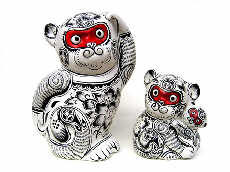 | 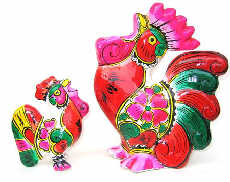 |
The craft of making painted clay-figurines of Fengxiang has a recorded history of more than 3,000 years.
According to archaeologists, the decorative designs of Fengxiang's figurines made in the WesternZhou Dynastywere different from those onbronzewareburied in the same period. The images of clay figurines typically included flowers, birds, fish, insects, as well as auspicious birds and beasts, reflecting cultural characteristics of ancient China.
The figurines are made of local clay, which was mixed with pulp and painted after it was shaped. The colors of Fengxiang figurines are extremely bright, and with intensive contrasts. With a black outline, they are primarily scarlet, green and yellow.
The figurines have a wide-range of subjects, includingfacial makeup, folklore, historical stories, rural life and others. Their bold and short shapes are widely exaggerated. The resonate with admirers, and are deeply loved by people at home and abroad.
In recent years, with the development of China's tourism, Fengxiang's clay - figurines have become one of the Shaanxi's important travel souvenirs.
 Clay Figurine Zhang and Huishan clay figurines
Clay Figurine Zhang and Huishan clay figurines
Chinese folk artists use simple and cheap materials to make small and delicate handicrafts, won great favor among folk people. In the Ming and Qing dynasties, painted clay figurines were very popular. The most famous were the Clay Figurine Zhang ( Niren Zhang) made inTianjinand the Huishan clay figurines made in Wuxi,Jiangsu Province.
 Clay Figurine Zhang
Clay Figurine Zhang
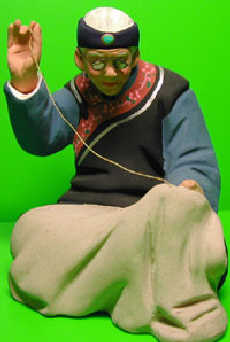 | 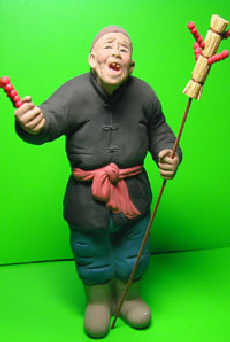 |
Clay Figurines Zhang was a kind of school of art in northern China. It was initiated by Zhang Mingshan in the lateQing Dynasty. Zhang Mingshan was born in a poor family in Tianjin. He learned from his father how to make clay figurines at a very young age. Zhang was clever, deft and full of imagination. He carefully observed people at different places, such as market fairs, theaters and so on. Then he would secretly make clay figurines of those he met and hide them inside his sleeves.
His clay figurines were very vivid and expressive, and Zhang and his figurines were soon well known in the surrounding area. Zhang not only inherited the legacy of traditional skills but also incorporated skills from other art forms such as painting, opera singing and Chinese folk wood engravings. He created more than 10,000 clay figurines during his life, and his unique handicrafts became famous both at home and abroad. People liked his clay figurines very much and gave him the nickname of Clay Figurine Zhang.

Clay figurines created by Zhang include heroes and villains from Chinese folk stories, novels, and operas as well as scenes from life, which are full of appeal.
Jiang Menshen,a local despot, is one of Zhang's most representative clay figurines. It is only 11 cm high, with a head in the size of a broad bean .
Jiang's distinguishing characteristics are vividly depicted. People can see there are some blue veins in his neck, and a murderous look on his face with raised eyebrows and downward curling lips.
His bulging belly and forbidding countenance seem to show he might show his bad temper at any time. Such a vivid and bold feature reveals Zhang's adept skills and a desire to expose and attack those evil forces.
 Huishan clay figurines
Huishan clay figurines
The Huishan clay figurines of Wuxi, Jiangsu Province are in a different style and have a long history.
In the slack seasons, nearly all families in Wuxi make clay figurines. When festivals approaching, many people sell clay figurines attempleand market fairs.
In the Qing Dynasty, there were some professional clay figurine workshops in Huishan. Clay figurine artist Wang Chunlin once made five plates of clay children to the EmperorQianlongand received high praise. From Emperor Tongzhi's to Guangxu's reign in the Qing Dynasty, more opera figurines were produced and Huishan clay figurine production reached its peak. At that time, there were over 40 clay figurine workshops and stores in Huishan, with more than 30 professional craft workers. When the Empress Dowager Cixi celebrated her 60th birthday, the local officer of Huishan presented a set of clay figurines named Immortality Peach Gathering. From then on, Huishan clay figurines were officially recognized as articles of tribute to the imperial court.
Huishan clay figurines include fine and coarse figurines. Coarse figurines are made from moulds and produced in large numbers. However, fine figurines are made by hand in the shapes of oxen,tigers, the God of Longevity and so on. Generally speaking, Huishan clay figurines are short in stature, full with big heads, and their facial expressions are vividly depicted. Bright red, yellow, green and blue colors are applied to them to make them more distinct and beautiful.
One piece particularly representative of Huishan clay figurines is Da A Fu, meaning "great good fortune." It features two lovely, plump children, a boy and a girl, each holding a tiny lion. The figurine is considered a symbol of happiness and auspiciousness. In 1992, it was made the official mascot of China International Tourism Year.
 Gaomi clay figurines
Gaomi clay figurines
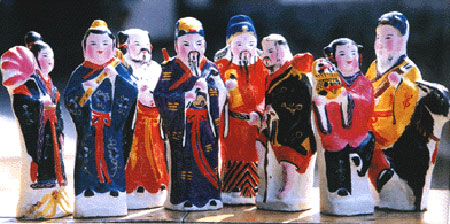
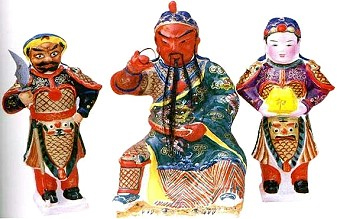
Gaomi (a place in Shandong) clay figurines have a history of 400 years. In the Long Qing and Wan Li periods of theMing dynasty, farmers in Gaomi designed a kind of skyrocket. People put powder into the clay idols, which were in the shapes of various animals, such as the tiger, lion, monkey, dog and some legendary figures. After fired, the idols were collected by people as decorations.
Gradually, the figurines were no longer the appendants of fireworks, but developed into a kind of independent handicraft. In the Qian Long's reign of Qing Dynasty, the local artists used the experience of Yang village's New Year Picture for reference, and made some innovations in expressions as well as colorations.
At present Gaomi clay sculptures have become a folk art and is protected and often exhibited in foreign countries.
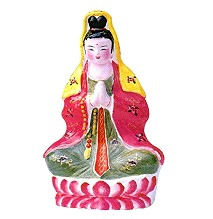
Author: Ivana

Presented by Chinadaily.com.cn Registration Number: 10023870-7
Copyright © Ministry of Culture, P.R.China. All rights reserved